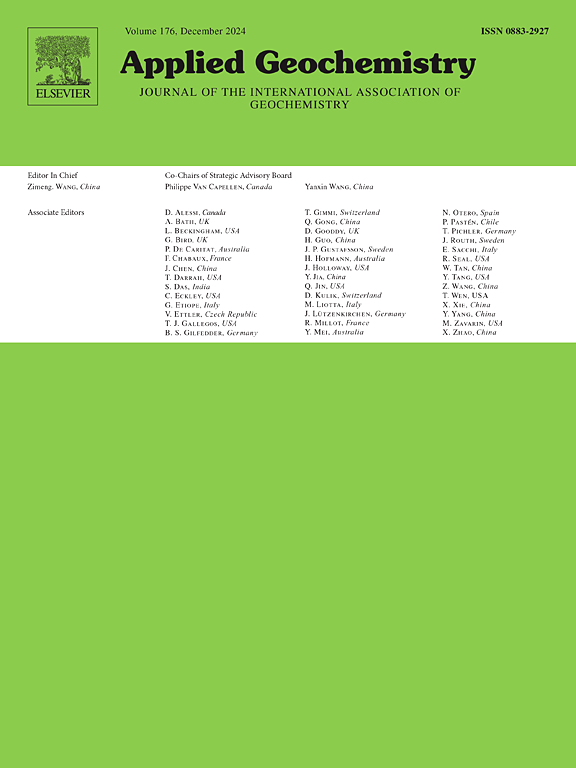Determination of CO2 and DIC in high-CO2 waters: An application for the analysis of coal mine waters
IF 3.4
3区 地球科学
Q1 GEOCHEMISTRY & GEOPHYSICS
引用次数: 0
Abstract
The impact of sulfuric-acid weathering on the global carbon cycle is increasingly being recognized as important in both recent and deep time estimates yet remains poorly constrained. Global-scale estimates of CO2 fluxes are hampered by the lack of data, especially for acidic waters. Mining-impacted groundwaters and associated discharges, which can be acidic and contain CO2 orders of magnitude greater than atmospheric equilibrium, are chemically unstable at the Earth surface and are often difficult to sample and accurately analyze. The direct CO2 method used herein is accurate and precise with holding times up to 25 days. This modified method allows for the determination of CO2 and DIC in samples lacking measurable alkalinity or having high CO2 pressures; these samples may otherwise be excluded from estimates of regional carbon fluxes. To demonstrate the method, natural and CO2-treated mine waters with pHs ranging from 3.1 to 7.1 were sampled and found to contain between 2 and 13 mM CO2 (88–572 mg CO2/L, 24–154 mg C/L) and 2–21 mM dissolved inorganic carbon, DIC (24–252 mg C/L). In comparison to standard DIC estimation methods, the direct method for analyzing CO2 and determining corresponding concentrations of DIC is more accurate and reproducible over holding times of several weeks for water samples containing low-to-high CO2 and with acidic-to-circumneutral pH.

高CO2水中CO2和DIC的测定:在煤矿水分析中的应用
人们越来越认识到硫酸风化对全球碳循环的影响在近期和远期估算中都很重要,但对其制约仍然不足。由于缺乏数据,尤其是酸性水体的数据,对二氧化碳通量的全球尺度估算受到阻碍。受采矿影响的地下水和相关排放物可能是酸性的,其二氧化碳含量比大气平衡状态高出几个数量级,在地球表面化学性质不稳定,通常难以取样和准确分析。本文使用的二氧化碳直接分析法准确、精确,保持时间长达 25 天。这种改进的方法可以测定缺乏可测量碱度或二氧化碳压力较高的样本中的二氧化碳和 DIC;否则,这些样本可能会被排除在区域碳通量估算之外。为了演示该方法,对 pH 值在 3.1 到 7.1 之间的天然矿井水和经过二氧化碳处理的矿井水进行了采样,结果发现这些矿井水含有 2 到 13 毫摩尔的二氧化碳(88-572 毫克 CO2/升,24-154 毫克 C/升)和 2-21 毫摩尔的溶解无机碳 DIC(24-252 毫克 C/升)。与标准的 DIC 估算方法相比,直接分析 CO2 和确定相应 DIC 浓度的方法更为准确,而且对于 CO2 含量从低到高以及 pH 值从酸性到中性的水样,在数周的保持时间内可重复使用。
本文章由计算机程序翻译,如有差异,请以英文原文为准。
求助全文
约1分钟内获得全文
求助全文
来源期刊

Applied Geochemistry
地学-地球化学与地球物理
CiteScore
6.10
自引率
8.80%
发文量
272
审稿时长
65 days
期刊介绍:
Applied Geochemistry is an international journal devoted to publication of original research papers, rapid research communications and selected review papers in geochemistry and urban geochemistry which have some practical application to an aspect of human endeavour, such as the preservation of the environment, health, waste disposal and the search for resources. Papers on applications of inorganic, organic and isotope geochemistry and geochemical processes are therefore welcome provided they meet the main criterion. Spatial and temporal monitoring case studies are only of interest to our international readership if they present new ideas of broad application.
Topics covered include: (1) Environmental geochemistry (including natural and anthropogenic aspects, and protection and remediation strategies); (2) Hydrogeochemistry (surface and groundwater); (3) Medical (urban) geochemistry; (4) The search for energy resources (in particular unconventional oil and gas or emerging metal resources); (5) Energy exploitation (in particular geothermal energy and CCS); (6) Upgrading of energy and mineral resources where there is a direct geochemical application; and (7) Waste disposal, including nuclear waste disposal.
 求助内容:
求助内容: 应助结果提醒方式:
应助结果提醒方式:


